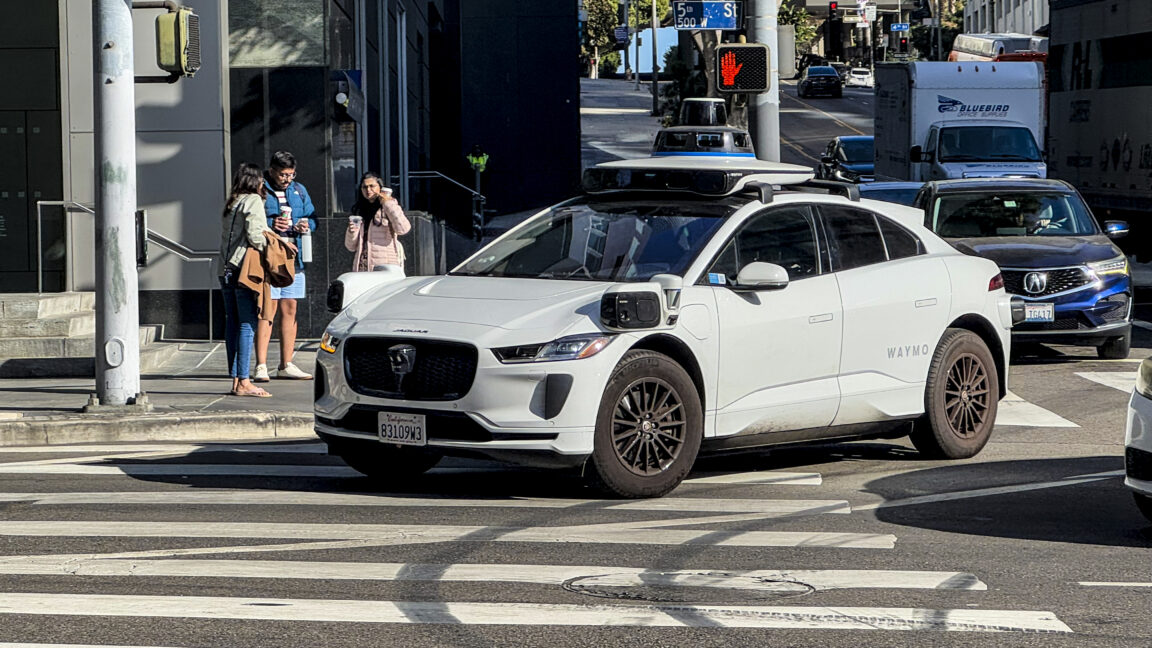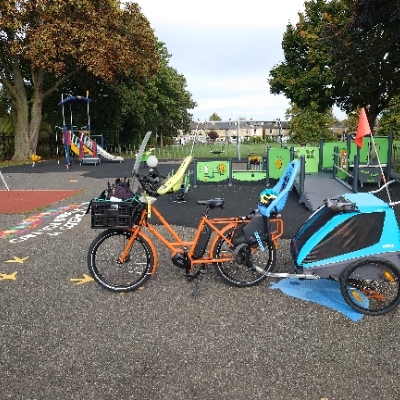That’s what happens when you have a reasonable sensor suite with LIDAR, instead of trying to rely entirely on cameras like Tesla does.
Musk: but-but-but people don’t have lidars and can drive! Lidars are expensive! Tesla go brrrrr.
Tesla go durrrrr
Tesla go 🔥🔥🔥🔥
At least the repair for a camera-only front is cheaper after the car crashes into a parked white bus
Tap for spoiler
/s
And are limited to highly trained routes. There’s a reason you only see them in specific neighborhoods of specific cities.
Why are we still doing this? Just fucking invest in mass transit like metro, buses and metrobuses. Jesus
Also, Note that this is based on waymo’s own assumptions, that’s like believing a 5070 gives you 4090 performance…
That doesn’t solve the last mile problem, or transport for all the people who live outside of a few dense cities.
Yes it does, if done properly. I have stops for four bus lines within walking distance. During peak hours, buses come once every 15 minutes. Trolleys in the city centre, every 10 minutes. Trams, every two minutes, and always packed. Most of the surrounding villages have bus stops. A lack of perspective is not an excuse.
Well if YOU have a bus stop near you then everyone must! That’s just science!
If you build it they will come
Yeah, all three of them.
Because having a bus to pick up 7 people in a day is really efficient economically and environmentally…
Much more so than having a car-centric infrastructure. If you start cherry-picking you’ll of course find cases where a car would have been more efficient but public transportation needs to be understood as a whole.
“most of the surrounding villages”
I live on a 40mph road with no sidewalk or shoulder. That is connected to a 45mph road with no sidewalk or shoulder. My nearest bus stop is 3.2 miles away.
I’m not even that far out, I can drive to a major city downtown in 30 minutes.
That’s great that you have all this infrastructure around you, but not everyone does. Like you said, a lack of perspective is not an excuse.
It’s better to have a few self driving cars that are safer than everyone owning their own car. It’s like getting gas guzzling vehicles off the road: better to replace a humvee with a sedan than a sedan with an electric.
Good thing we basically got rid of sedans in favor of “light truck” SUVs…
ROFL ya because taking 5 separate buses to get to work is TOTALLY going to encourage people to get rid of their cars.
Fucking brilliant.
Oh ya and I TOTALLY want to give up my car just so I can be forced to sit next to rude assholes coughing in my face.
These brilliant suggestions are amazing.
Jesus. Ten of the hottest years ever recorded were the last ten. Its time for some major changes. If more people rode public transport it would be better.
All your objections seem to be about how inconvenient it would be for you. Sound kinda self-centered. Act like the only way to get by is to continue to conspicuously consume everything. Get a fuckin grip.
Edited with less profanity and name calling
Fella it isn’t me you need to convince. It’s the billions of other people on the planet you need to convince.
If you think you can force the entire world then by all means and try.
And also clearly you. As you seem to have decided you won’t participate until every single one of the other billions do.
Pretty much. I’m not trashing my life and living in the slums while the rest of the world doesn’t care.
If the world wants more from me then they can step up too.
5 separate buses
Holy hyperbole, Batman!
To get to work 25 miles away, it takes 2 trains (commuter and light rail) and a bus. I personally don’t take transit though, not because of the other passengers, but because of how infrequent those lines run, which turns what should be an hour commute into two, each way.
I have zero problem with transit and I actually alternated between cycling and the bus to my last job based on weather, which took a out 40 min regardless of method of transport (about 10 miles away, two buses).
I can get to most popular destinations in my area with about 3 transfers, and the most popular ones would be one transfer (commuter train to light rail). The main limiting factor is ridership and feeder lines. I even have a rail line that goes right through my suburban city (and a bunch of others) that connects to light rail lines, but that extension keeps getting delayed. If they built the line, it would shave an hour off my transit commute and connect me to multiple destinations (two pro stadiums and downtown), but no, we get wider highways instead, and still have terrible traffic (sometimes it’s slower than the 2 trains + bus that takes 2 hours).
Frankly the best solution i have seen is always a combination of things. At least in the city I live in, people can take bikes on buses and trains, many people walk, and for trips that require trunk space (e.g furniture, DIY supplies etc) there is a Car sharing service that is cheaper than owning a car, or using ride share / taxi.
I don’t think waymo is a better option than a combination of what’s above, I think it can perhaps compliment it but it should not be the sole last-kilometre solution.
I would like to see waymo-like tech provide better public transit for the disabled. As of now, people in my city with disabilities can book special routes which are serviced by specialized buses/ taxis, and existing lines are all wheelchair accessible as well.
Self driving cars give the opportunity for those people to have even more freedom in booking, since as of now they can’t do last minute booking for the custom routes. It wouldn’t really create a traffic problem and massively would increase quality of life for those who are sadly disadvantages in society
Why are we still doing this?
Because there’s a lot of money in it. 10.3% of the US workforce works in transportation and warehousing. Trucking alone is the #4 spot in that sector (1.2 million jobs in heavy trucks and trailers). Couriers and delivery also ranks highly.
The self-driving vehicles are targeting whole markets and the value of the industry is hard to underestimate. And yes, even transit is being targeted (and being implemented; see South Korea’s A21 line). There’s a lot of crossover with trucking and buses, not to mention that 42% of transit drivers are 55+ in age. Hiring for metro drivers is insanely hard right now.
Taking waymo’s numbers at face value they are almost 20x more dangerous than a professional truck driver in the EU. This is a personal convenience thing for wealthy people, that’s it. Fucking over jarvis and Mahmood so we can have fleets of automated ubers…
It’s nonsensical to compare protected highway miles with surface city street miles.
Uber had a net income of 9.86 billion dollars and spent 7.14 billion in operations in 2024. That’s a single transportation company. Do you really think Uber or anyone else is going to ignore researching the technology that could significantly reduce their billions in operations costs?
I’m also not so sure that Europe is 20x safer than the US. A quick search pulled up the International Transport Form’s Road Safety Annual Report 2023 and their data disagrees. The US, even with its really poor showing in the general numbers, is safer than Poland and Czechia (Road fatalities per billion vehicle‑kilometres, 2021). I could see an argument for a 2x gap of Europe outdoing the US, but a 20x? Citation needed.
They’re not saying general road safety is 20x better. They’re comparing an automated car ONLY on surface streets with lights, intersections, pedestrians, dogs, left turns, etc… to a professional truck driver mostly on highway miles.
So we can have autonomous metros, buses and taxis that allow people anywhere when they need it so they don’t rely on having a car?
There’s already an autonomous metro.
Where? I haven’t heard of any rail lines that don’t have a human operator onboard or somewhere in the loop?
i.e. Every single line in Copenhagen.
Budapest line M4 is fully automated, stations have some personnel but otherwise you can get on a train and look out straight ahead through the window, there is no cab.
Trains drive themselves, but I imagine there must be some switchboard type of thing somewhere.
deleted by creator
This would be more impressive if Waymos were fully self-driving. They aren’t. They depend on remote “navigators” to make many of their most critical decisions. Those “navigators” may or may not be directly controlling the car, but things do not work without them.
When we have automated cars that do not actually rely on human being we will have something to talk about.
It’s also worth noting that the human “navigators” are almost always poorly paid workers in third-world countries. The system will only scale if there are enough desperate poor people. Otherwise it quickly become too expensive.
@Curious_Canid @vegeta this is the case for the Amazon “just walk out” shops as well. Like Waymo they frame it as the humans “just doing the hard part” but who knows what “annotating” means in this context? And notably it’s clearly more expensive to run than they thought as they’ve decided to do Dash Carts instead which looks like it’s basically a portable self-service checkout. The customer does the checking. https://www.theverge.com/2024/4/17/24133029/amazon-just-walk-out-cashierless-ai-india
Back when I was a fabricator I made some of the critical components used in Amazon stores. Amazon was incredibly particular about every little detail, even on parts that didn’t call for tight tolerancing in any conceivable way. They, on several occasions, sent us one bad set of prints after another. Which we could only discover after completing a run of parts. We’re talking 20-30 thousand units that ended up being scrapped because of their shitty prints. Millions of dollars set on fire, basically.
They became such a huge pain in the ass to work with we eliminated every single SKU they ordered from us.
@SippyCup I have never heard a single good thing from anyone who works with or for them.
Ordering components with unnecessarily small tolerances is stupid and a waste of money but of course they will complain if you can’t make the parts to the specifications.
Why did you even take the order in the first place if you can’t manage to produce them to spec?
of course they will complain if you can’t make the parts to the specifications.
Why did you even take the order in the first place if you can’t manage to produce them to spec?
Where did they say anything about not being able to make the parts to spec?
Why did you even take the order in the first place if you can’t manage to produce them to spec?
They were made to spec, but the specs were wrong.
We produced everything to spec and on time, thanks.
Yeah we managed to just put the slave workers behind a further layer of obfuscation. Not just relegated to their own quarters or part of town but to a different city altogether or even continent.
Tech dreams have become about a complete lack of humanity.
I saw an article recently, I should remember where, about how modern “tech” seems to be focused on how to insert a profit-taking element between two existing components of a system that already works just fine without it.
That’s called “rent-seeking behavior,” and it’s not new
Was it The Enshittification?
deleted by creator
“Damn, I’m sorry my car killed your kids. The Carscape person didn’t get their drop”
deleted by creator
Packaging the job as a video game side quest is genius. Make so the gamer has to do several simulated runs before they connect to an actual car, and give in-game expensive consequences for messing it up
deleted by creator
I thought the human operators only step in when the emergency button is pressed or when the car gets stuck?
Do they actually get driven by people in normal operation?
The claim is that the remote operators do not actually drive the cars. However, they do routinely “assist” the system, not just step in when there’s an emergency.
I think they’ve got 1 person watching dozens of cars though, it’s not 1 per car like if there was human drivers.
Could a navigator run you over twice from different companies after they get fired from the first one?
Sequel to snowcrash right there
i knew it that AI is just some guy in india responding to my queries.
AI - Actually Indian
I am once again begging journalists to be more critical
of tech companies.But as this happens, it’s crucial to keep the denominator in mind. Since 2020, Waymo has reported roughly 60 crashes serious enough to trigger an airbag or cause an injury. But those crashes occurred over more than 50 million miles of driverless operations. If you randomly selected 50 million miles of human driving—that’s roughly 70 lifetimes behind the wheel—you would likely see far more serious crashes than Waymo has experienced to date.
[…] Waymo knows exactly how many times its vehicles have crashed. What’s tricky is figuring out the appropriate human baseline, since human drivers don’t necessarily report every crash. Waymo has tried to address this by estimating human crash rates in its two biggest markets—Phoenix and San Francisco. Waymo’s analysis focused on the 44 million miles Waymo had driven in these cities through December, ignoring its smaller operations in Los Angeles and Austin.
This is the wrong comparison. These are taxis, which means they’re driving taxi miles. They should be compared to taxis, not normal people who drive almost exclusively during their commutes (which is probably the most dangerous time to drive since it’s precisely when they’re all driving).
We also need to know how often Waymo intervenes in the supposedly autonomous operations. The latest we have from this, which was leaked a while back, is that Cruise (different company) cars are actually less autonomous than taxis, and require >1 employee per car.
edit: The leaked data on human interventions was from Cruise, not Waymo. I’m open to self-driving cars being safer than humans, but I don’t believe a fucking word from tech companies until there’s been an independent audit with full access to their facilities and data. So long as we rely on Waymo’s own publishing without knowing how the sausage is made, they can spin their data however they want.
edit2: Updated to say that ournalists should be more critical in general, not just about tech companies.
Journalist aren’t even critical of police press releases anymore, most simply print whatever they’re told verbatim. It may as well just be advertisement.
I agree with you so strongly that I went ahead and updated my comment. The problem is general and out of control. Orwell said it best: “Journalism is printing something that someone does not want printed. Everything else is public relations.”
The meat of the true issue right here. Journalism and investigative journalism aren’t just dead, their corpses has been feeding a palm tree like a pod of beached whales for decades. It’s a bizarre state of affairs to read news coverage and come out the other side less informed, without reading literal disinformation. It somehow seems so much worse that they’re not just off-target, but that they don’t even understand why or how they’re fucking it up.
I was going to say they should only be comparing them under the same driving areas, since I know they aren’t allowed in many areas.
But you’re right, it’s even tighter than that.
These articles frustrate the shit out of me. They accept both the company’s own framing and its selectively-released data at face value. If you get to pick your own framing and selectively release the data that suits you, you can justify anything.
@[email protected] @[email protected]
to amplify the previous point, taps the sign as Joseph Weizenbaum turns over in his graveA computer can never be held accountable
Therefore a computer must never make a management decision
tl;dr A driverless car cannot possibly be “better” at driving than a human driver. The comparison is a category error and therefore nonsensical; it’s also a distraction from important questions of morality and justice. More below.
Numerically, it may some day be the case that driverless cars have fewer wrecks than cars driven by people.(1) Even so, it will never be the case that when a driverless car hits and kills a child the moral situation will be the same as when a human driver hits and kills a child. In the former case the liability for the death would be absorbed into a vast system of amoral actors with no individuals standing out as responsible. In effect we’d amortize and therefore minimize death with such a structure, making it sociopathic by nature and thereby adding another dimension of injustice to every community where it’s deployed.(2) Obviously we’ve continually done exactly this kind of thing since the rise of modern technological life, but it’s been sociopathic every time and we all suffer for it despite rampant narratives about “progress” etc.
It will also never be the case that a driverless car can exercise the judgment humans have to decide whether one risk is more acceptable than another, and then be held to account for the consequences of their choice. This matters.
Please (re-re-)read Weizenbaum’s book if you don’t understand why I can state these things with such unqualified confidence.
Basically, we all know damn well that whenever driverless cars show some kind of numerical superiority to human drivers (3) and become widespread, every time one kills, let alone injures, a person no one will be held to account for it. Companies are angling to indemnify themselves from such liability, and even if they accept some of it no one is going to prison on a manslaughter charge if a driverless car kills a person. At that point it’s much more likely to be treated as an unavoidable act of nature no matter how hard the victim’s loved ones reject that framing. How high a body count do our capitalist systems need to register before we all internalize this basic fact of how they operate and stop apologizing for it?
(1) Pop quiz! Which seedy robber baron has been loudly claiming for decades now that full self driving is only a few years away, and depends on people believing in that fantasy for at least part of his fortune? We should all read Wrong Way by Joanne McNeil to see the more likely trajectory of “driverless” or “self-driving” cars.
(2) Knowing this, it is irresponsible to put these vehicles on the road, or for people with decision-making power to allow them on the road, until this new form of risk is understood and accepted by the community. Otherwise you’re forcing a community to suffer a new form of risk without consent and without even a mitigation plan, let alone a plan to compensate or otherwise make them whole for their new form of loss.
(3) Incidentally, quantifying aspects of life and then using the numbers, instead of human judgement, to make decisions was a favorite mission of eugenicists, who stridently pushed statistics as the “right” way to reason to further their eugenic causes. Long before Zuckerberg’s hot or not experiment turned into Facebook, eugenicist Francis Galton was creeping around the neighborhoods of London with a clicker hidden in his pocket counting the “attractive” women in each, to identify “good” and “bad” breeding and inform decisions about who was “deserving” of a good life and who was not. Old habits die hard.So let me make sure I understand your argument. Because nobody can be held liable for one hypothetical death of a child when an accident happens with a self driving car, we should ban them so that hundreds of real children can be killed instead. Is that what you are saying?
As far as I know of, Waymo has only been involved in one fatality. The Waymo was sitting still at a red light in traffic when a speeding SUV (according to reports going at extreme rate of speed) rammed it from behind into other cars. The SUV then continued into traffic where it struck more cars, eventually killing someone. That’s the only fatal accident Waymo has been involved in after 50 million miles of driving. But instead of making it safer for children, you would prefer more kids die just so you have someone to blame?
So let me make sure I understand your argument. Because nobody can be held liable for one hypothetical death of a child when an accident happens with a self driving car, we should ban them so that hundreds of real children can be killed instead. Is that what you are saying?
No, this strawman is obviously not my argument. It’s curious you’re asking whether you understand, and then opining afterwards, rather than waiting for the clarification you suggest you’re seeking. When someone responds to a no-brainer suggestion, grounded in skepticism but perfectly sensible nevertheless, with a strawman seemingly crafted to discredit it, one has to wonder if that someone is writing in good faith. Are you?
For anyone who is reading in good faith: we’re clearly not talking about one hypothetical death, since more than one real death involving driverless car technology has already occurred, and there is no doubt there will be more in the future given the nature of conducting a several-ton hunk of metal across public roads at speed.
It should go without saying that hypothetical auto wreck fatalities occurring prior to the deployment of technology are not the fault of everyone who delayed the deployment of that technology, meaning in particular that these hypothetical deaths do not justify hastening deployment. This is a false conflation regardless of how many times Marc Andreesen and his apostles preach variations of it.
Finally “ban”, or any other policy prescription for that matter, appeared nowhere in my post. That’s the invention of this strawman’s author (you can judge for yourself what the purpose of such an invention might be). What I urge is honestly attending to the serious and deadly important moral and justice questions surrounding the deployment of this class of technology before it is fully unleashed on the world, not after. Unless one is so full up with the holy fervor of technoutopianism that one’s rationality has taken leave, this should read as an anodyne and reasonable suggestion.
I was asking in good faith because the way you talk is not easily comprehensible. I can barely follow whatever argument you are trying to make. I think you are trying to say that we shouldn’t allow them on the road until we have fully decided who is at fault in an accident?
Also, only one death has occurred so far involving driverless cars, which is where a speeding SUV rammed into a stopped driverless car and then the SUV continued on and hit 5 other cars where it killed someone. That’s it. The only death involved a driverless car sitting still, not moving, not doing anything… and it wasn’t even the car that hit the car in which the person died. So I would say it is hypothetical when talking about hypothetical deaths that are the fault of a driverless car.
Honestly I should just get that slide tattooed to my forehead next to a QR code to Weizenbaum’s book. It’d save me a lot of talking!
But when it does crash, will Google accept the liability?
Probably depends who is at fault. I also would be that Google has insurance for this sort of thing.
They consult Gemini. If it gives a cogent answer, they consider it a “yes”. So, no.
They both own and operate the car. Even if it was a manned taxi, they’d be liable.
No shit. The bar is low. Humans suck at driving. People love to throw FUD at automated driving, and it’s far from perfect, but the more we delay adoption the more lives are lost. Anti-automation on the roads is up there with anti-vaccine mentality in my mind. Fear and the incorrect assumption that “I’m not the problem, I’m a really good driver,” mentality will inevitably delay automation unnecessarily for years.
It’d probably be better to put a lot of the R&D money into improving and reinforcing public transport systems. Taking cars off the road and separating cars from pedestrians makes a bigger difference than automating driving.
In my country at least (US) that’s just not going to happen.
WVU has a tram system called the “PRT”. It’s semi-automated cars on a track around campus and downtown. It’s not great, but goddamn does it handle a large school population just fine. Very high throughput, and it keeps congestion down. … as down as you can be with such a high density town.
That, and the inevitable bureaucratic nightmare that awaits for standardising across makes and updating the infrastructure.
Car infrastructure was a mistake. Automation isn’t the solution, it’s less cars and car-based spaces.
Why not both? We can automate the trains (more), the busses, and the occasional rural drive.
Sure that’s great, but read the room. It’s like advocating for gun legislation in the US, it can only go so far realistically. The vast majority of US cities are built around automotive infrastructure and the culture is very much anti-public transport. That requires heavy government level buy in. Car automation can be driven primarily by industry. One can happen in a major way in a few years, the other will take decades if it happens at all. Personally I’m all for it, but it’s such a different discussion that it just comes across as distracting when talking about very real delays in car automation and it’s not a valid criticism of moving forward and promoting decreased barriers to fully automated vehicle infrastructure.
The rural drive is the fun one, though…
Automation also can be abused, which I’m very very cautious about.
“Waymo reports that Waymo cars are the best”
“Waymo reports the statistical data it has, which happens to be pretty good.”
Unprofessional human drivers (yes, even you) are unbelievably bad at driving, it’s only a matter of time, but call me when you can do it without just moving labor done by decently paid locals to labor done remotely in the third world.
That doesn’t seem like a very high bar to achieve
How are they with parking lots, tho’?
Or yielding to emergency vehicles.
I think “veritasium” or what the yt channel is called made a video about those.
It did manage to bring him to a store with a big parking lot, it did it.
They work great in parking lots.
Source: Ridden in several Waymos
Just fine the one time I rode in one. It had a problem with a moving truck blocking the entire street, where it sat trying to wait to see if the moving truck was just stopped and going to move or if it was parked for good. The Waymo executed a 3 point turn and then had two construction trucks pull into the street the other direction, and they refused to back up. So the Waymo was stuck between not going forward and not going back… it just pulled forward toward the trucks and then reversed toward the moving truck. Back and forth. Then I yelled out the window for the fucking trucks to move out of the fucking road, which they couldn’t drive down anyway. After that it was smooth, even getting into the parking lot.
My buddy said at his office the Waymos have an issue with pulling too far forward at the pick up spots, which makes it impossible for cars to go around them, but humans do dumb shit like that, too.
“After 6 miles, Teslas crash a lot more than human drivers.”
I hate felon musk but I honestly believe their self driving tech is safer than humans.
Have you seen the average human? They’re beyond dumb. If they’re in cars it’s like the majority of htem are just staring at their cell phones.
I don’t think self driving tech works in all circumstances, but I bet it is already much better than humans at most driving, especially highway driving.
Your username is a lie huh?
I had a friend that worked for them in the past. They really aren’t that impressive. They get stuck constantly. While the tech down the line might be revolutionary for people who cannot drive for whatever reason right now it still needs a LOT of work.
@MoreFPSmorebetter @vegeta I just can’t see this type of tech working in places with a more pedestrian-first culture / more unpredictable human behaviour, i.e. countries without jaywalking laws. If you tried to drive this through London and people realised it will just have to automatically stop for you (and also *won’t* stop for you out of politeness if you wait hopefully) then everyone will just walk in front of it. What’s the plan, special “don’t stop the Waymo” laws?
Vegas sure has a lot of pedestrians doing a whole lot of unpredictable things.
@ripcord unpredictable but maybe not standard practice? Just a guess, could be a bad assumption! British driving culture is reliant on eye contact and waves and nods and flashes - you have to signal if you’re giving way (to other drivers as well), and say thank you; lots of places where there’s only room for one vehicle on a two way road and someone has to decide who’s going. Might be my failure of imagination but I don’t know how that works with no driver.
That’s when vehicle to vehicle communication will come into play. When we can automate the driving and link the cars’ comm systems together, it becomes a network management problem.
@dogslayeggs this is not a good solution unless you’re expecting to mandate that all pedestrians, cyclists, scooter riders, guide dogs, whatever, wear them too, and that all existing cars are retrofitted with them. Kind of dystopian.
It is absolutely common for people to do something unexpected in Las Vegas, particularly near the Strip and other pedestrian-heavy, gambling/drinking-heavy areas.
Erratic driving is also higher than average for most western cities.
My point though was that this is one of Waymo’s main testing areas.
With that said, like other people have mentioned, there are a lot of potential gotchas here like Waymo running on fairly limited routes and still potentially needing a lot of human intervention.
Also the idea that someone can shut down or take over control of my car remotely is extremely creepy and dust I piano seeming to me.
Obviously we install a padded arm that grabs the pedestrians and throws them back onto the curb so they learn not to just walk out in front of the moving vehicles.
Idk how it is where y’all live but generally people only jaywalk when there aren’t cars driving on the road at that moment. Other than crosswalks it’s kinda expected that if you are going to jaywalk you are going to do it when no car will have to stop or slow down to avoid you. Obviously not everyone follows that rule but generally speaking.
People in London just walk in front of all cars all the time. Including me. That’s not an unpredictable behaviour, that’s a default and very predictable behaviour. If you’re in a car - you stop.
@Aux I’d call it “predictably unpredictable”! Plus the “cyclist swerving round a pothole” roulette.
I believe it, but they also only drive specific routes.
What’s tricky is figuring out the appropriate human baseline, since human drivers don’t necessarily report every crash.
Also, I think it’s worth discussing whether to include in the baseline certain driver assistance technologies, like automated braking, blind spot warnings, other warnings/visualizations of surrounding objects, cars, bikes, or pedestrians, etc. Throw in other things like traction control, antilock brakes, etc.
There are ways to make human driving safer without fully automating the driving, so it may not be appropriate to compare fully automated driving with fully manual driving. Hybrid approaches might be safer today, but we don’t have the data to actually analyze that, as far as I can tell.
There’s a limit to what assist systems can do. Having the car and driver fighting for control actually makes everything far less safe.
And yet it’s still the least efficient mode of transport.
What’s more efficient?
In terms of getting to an exact location.
Public transportation only can get you near your target mostly. Not on point like a car, bike etc.
Good transit gets you close enough (as others have said, you don’t drive your car down the aisles of the supermarket). That few people have good transit is the problem that needs to be fixed. Sadly few really care - in the US the republicans hate transit, and the democrats only like transit for the union labor is employees - importantly neither cares about getting people places.
Bicycles? ride/ walk to were you need to be? Why do you need to be driven to an exact point? All the space needed for parking is just wasted.
You need to create a specific scenario in order to make cars seem more efficient than alternatives. They cause more accidents, take up more space while carrying fewer people at any given time while also causing more pollution than other modes of transport.
Automated vehicles are GPS guided. The US is too big to be walking and biking. That is for an urban environment with proper zoning laws, proper planning, and serves what amounts to be an ethnic group who shouldn’t need cars. What makes automated vehicles more efficient is the removal of labor and lower operational costs. The specialization of transporting people to the exact GPS coordinates is much more convenient. The future is automated travel because vehicles can be used more productively on the margin than everybody having to own their own car. Fewer cars, higher use of the car, or less idling, means lower transportation costs throughout, which includes infrastructure itself; the less need for insurance, less pollution, etc. This technology can be used in bus transit but in a potentially dynamic way.
The “US is too big” is such a bullshit excuse since cars are absolutely crap for long distances compared to trains people already walk and cycle in the US. And why is the richest and most powerful (for now at least) country in the world unable to fix it’s zoning laws? Especially since other countries seem to be able to do it.
Yes, efficiency in reducing the amount of people with jobs but not by getting people from a to b. What is convenient is not having to own a car in the first place and be able to get around with ease because of proper urban planning.
The future is automated travel because vehicles can be used more productively on the margin than everybody having to own their own car. Fewer cars, higher use of the car, or less idling, means lower transportation costs throughout, which includes infrastructure itself; the less need for insurance, less pollution, etc. This technology can be used in bus transit systems as well for a less marginal benefit.
Sooo like a what’s already possible with trains and trams? And buses on dedicated lanes would be far easier to automate and be more efficient than cars.
Trains are for long distances. Trams are for pure urban areas. Metros are for connecting cities within a metropolitan group. All those function within a well planned urban structure, not the suburbs, or exurbs. Cars are the most efficient in the US. That is why most Americans own a car. Without a car, you are asking for long walking distances, and long bike rides. City transit systems don’t work in the US, because too many criminals are out in public, people like their own space, and Americans like the convenience of going, and leaving at their own time. Americans like their own space. Again, you are talking about a specific type of living that most Americans don’t really gravitate to. Americans want a large house in a safe neighborhood in the suburbs, or live in the exurbs. They don’t want to live in crime-ridden urban areas, that is not the American dream.
Look how well that American dream is going
lol
In terms of getting to an exact location, the most efficient is no vehicle, walking.
Cars are less efficient, followed by busses, then probably trains, then boats, then airplanes (unless you parachute).
Cars are the least efficient in terms of moving large numbers of people from places they can then walk from.
The most efficient is obviously a combination of methods, using the fastest methods for each leg of the journey.
In the US, right now, taking a car from point to point, then walking into your location is the fastest combination in most cases.
It is hard to take you seriously. Open up Google Maps in the USA, and see how long it takes you to walk, and bike to a place. People buy the expense of a car for a reason; biking, and walking, is the least efficient. Transit systems do not work in the US, because everything has to be planned around them. They’re bureaucratic, and rote. City transit systems are the essence of this bureaucracy and rote. It does not serve people as they intend to live.
You ever heard of legs? Mass transit gets you the bulk of the way there, and legs will handle the small bit left.
If someone can’t walk a few blocks, that’s on them. Airplanes don’t get you exactly to the destination either. There’s a tradeoff.
E: For all the “What about the elderly or disabled?” If they can’t walk a few blocks and also can’t afford a car or taxi/Uber, what should they do? Mobility devices exist. Handicap accessible buildings are federally required. Your argument is merely a thought terminating interruption. That problem can easily be addressed.
@meco03211 @Jayk0b cars can’t either - it’s a false premise. Not everything is drive-thru. How far is, say, the bakery section from your car when you go to the supermarket?
Rip disabled people.
Yeah fuck disabled and elderly people.
Public transportation and walkable cities are much better for the elderly and disabled who often can’t drive due to their age and disability?
Taking a wheel chair or mobility scooter or be guided by your service dog are all subsets of “walk there”.






















